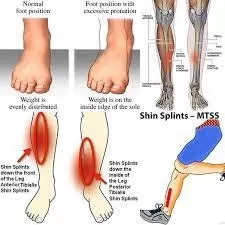
when the arch on the inside of feet is flattened, allowing the entire sole of your foot to touch the floor when stand up is called flat foot. A common and usually painless condition, flatfeet may occur when the arches don’t develop during childhood. In other cases, flatfeet may develop after an injury or from the simple wear-and-tear stresses of age. Flatfeet can sometimes contribute to problems in your ankles and knees because the condition can alter optimal alignment of your legs. If you aren’t experiencing any pain, no treatment is usually necessary for flatfeet. Most people have no signs or symptoms associated with flatfeet. But some people with flatfeet experience foot pain, particularly in the heel or arch area. Swelling along the inside of the ankle may also occur. A flat foot is normal in infants and toddlers, because the foot’s arch hasn’t yet developed. Most people’s arches develop throughout childhood, but some people never develop arches. This is a normal variation in foot type, and people without arches may or may not have problems. Arches can also fall over time. Years of wear and tear can weaken the tendon that runs along the inside of your ankle and helps support your arch
Factors that can increase your risk of flatfeet include: Obesity, Traumatic injury to your foot or ankle, Rheumatoid arthritis, Aging.
-
- X-rays. A simple X-ray uses a small amount of radiation to produce images of the bones and joints in your feet. It’s particularly useful in detecting arthritis.
- Computerized tomography (CT scan). This test takes X-rays of your foot from many different angles and provides much more detail than a standard X-ray.
- Ultrasound. If your doctor suspects an injured tendon, he or she may request an ultrasound test — which uses sound waves to produce detailed images of soft tissues within the body.
- Magnetic resonance imaging (MRI). Using radio waves and a strong magnet, MRIs provide excellent detail for both hard and soft tissues.
No treatment is necessary for flatfeet if you aren’t experiencing any pain.
Therapy
If flatfeet are painful, might suggest:
-
- Arch supports (orthotic devices). Over-the-counter arch supports may help relieve the pain caused by flatfeet. Or your doctor might suggest custom-designed arch supports, which are molded to the contours of your feet. Arch supports won’t cure flatfeet, but they often reduce symptoms.
- Stretching exercises. Some people with flatfeet also have a shortened Achilles tendon. Exercises to stretch this tendon may help.
- Proper shoe wear. A structurally supportive shoe may be better tolerated than sandals or shoes with minimal support.
Surgery
Surgery is not performed solely for the purpose of correcting flat feet. Surgery may be performed for an associated problem such as a tendon tear or rupture.
If you’re experiencing minor pain from flatfeet, you might want to try:
-
- Rest. Avoid activities that aggravate your condition. Participate in low-impact activities — such as walking, biking or swimming — rather than jumping and running activities.
- Arch supports. A trial of over-the-counter arch supports is reasonable to consider.
- Medications. Over-the-counter pain relievers may help.
- Weight loss. Losing weight can reduce the amount of stress on your feet.



